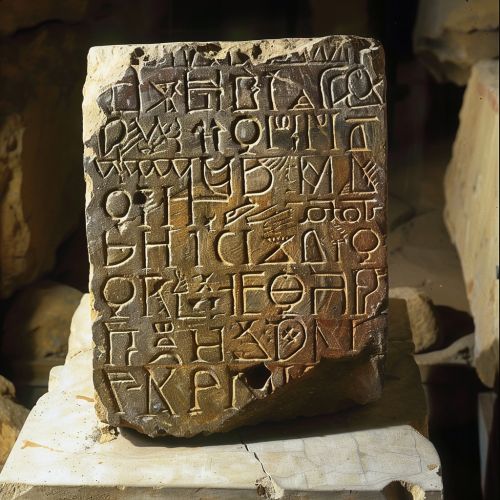Etruscan alphabet
Introduction
The Etruscan alphabet is an ancient writing system used by the Etruscans, a pre-Roman civilization in Italy. The alphabet is of significant historical interest due to its influence on the development of the Latin script, which forms the basis of many modern alphabets, including the English alphabet. The Etruscan alphabet itself was derived from the Greek script, which the Etruscans adapted to suit their language.
Origins and Development
The Etruscan alphabet originated around the 8th century BCE. It is believed to have been adapted from the Western Greek alphabet, specifically the variant used by the Greek colonies in southern Italy. The Etruscans modified the Greek letters to better fit the phonological structure of their own language, which had sounds not present in Greek.
The earliest Etruscan inscriptions date back to approximately 700 BCE. These inscriptions were primarily found on pottery, metal objects, and stone monuments. The alphabet underwent several changes over the centuries, reflecting the evolving linguistic and cultural practices of the Etruscan people.
Structure and Characteristics
The Etruscan alphabet consists of 26 letters, many of which closely resemble their Greek counterparts. However, the Etruscans introduced several unique modifications. For example, they added letters to represent sounds that did not exist in Greek, such as the aspirated consonants.
The alphabet is written from right to left, although some inscriptions show a boustrophedon style, where the direction of writing alternates with each line. This bidirectional writing is a characteristic shared with some early Greek inscriptions.


Phonology and Orthography
The Etruscan language had a rich phonological system, which included both voiced and voiceless consonants, as well as a variety of vowels. The Etruscan alphabet was designed to accommodate these sounds, although it did not always do so perfectly.
One notable feature of Etruscan orthography is the use of double consonants to indicate long consonantal sounds. This practice is similar to the gemination seen in modern Italian. Additionally, the Etruscans used a system of vowel length distinction, which was not explicitly marked in the writing but inferred from the context.
Inscriptions and Texts
Etruscan inscriptions have been found on a wide range of objects, including pottery, mirrors, and tombstones. These inscriptions provide valuable insights into Etruscan society, religion, and daily life. The texts range from short labels and names to longer religious and legal documents.
One of the most famous Etruscan texts is the Liber Linteus Zagrabiensis, a linen book that contains a religious calendar. This text is the longest Etruscan inscription known to date and provides a rare glimpse into Etruscan religious practices.
Influence on Other Alphabets
The Etruscan alphabet had a significant impact on the development of other writing systems, particularly the Latin alphabet. The Romans adopted and adapted the Etruscan script, making several modifications to suit the Latin language. Many letters in the modern Latin alphabet, such as A, B, and C, can trace their origins back to the Etruscan script.
The Etruscan influence is also evident in the alphabets of other Italic peoples, such as the Umbrians and the Oscans. These alphabets share several features with the Etruscan script, reflecting the cultural and linguistic interactions among the ancient Italic tribes.
Decline and Legacy
The use of the Etruscan alphabet declined with the rise of Roman power in Italy. By the 1st century BCE, the Etruscan language and script had largely fallen out of use, replaced by Latin. However, the legacy of the Etruscan alphabet endures through its influence on the Latin script and, by extension, many modern alphabets.
The study of the Etruscan alphabet continues to be a vibrant field of research. Scholars analyze inscriptions to gain insights into Etruscan language, culture, and history. Advances in technology, such as digital imaging and computational linguistics, are opening new avenues for the study of this ancient script.
